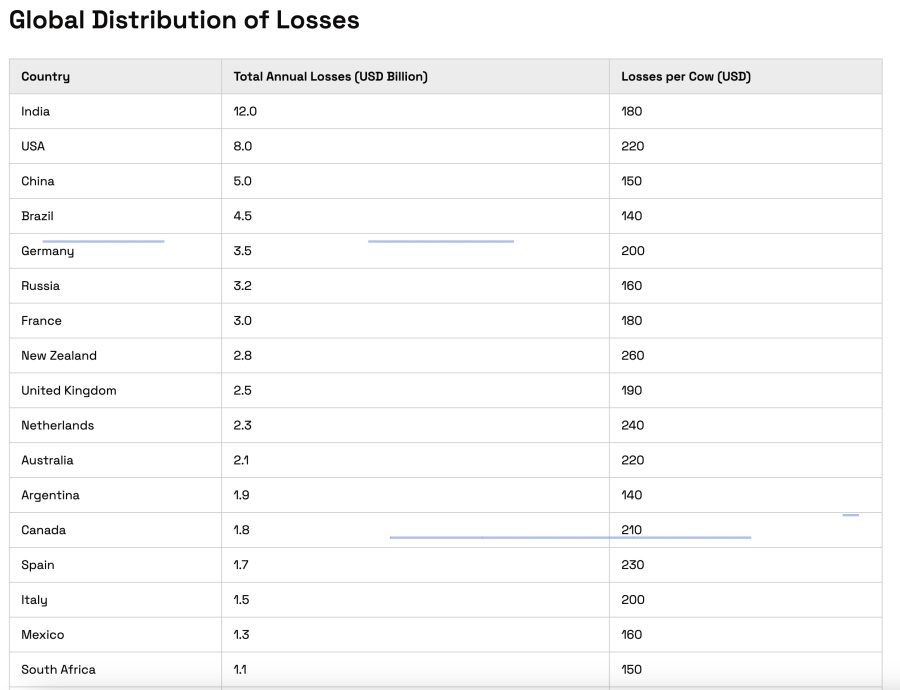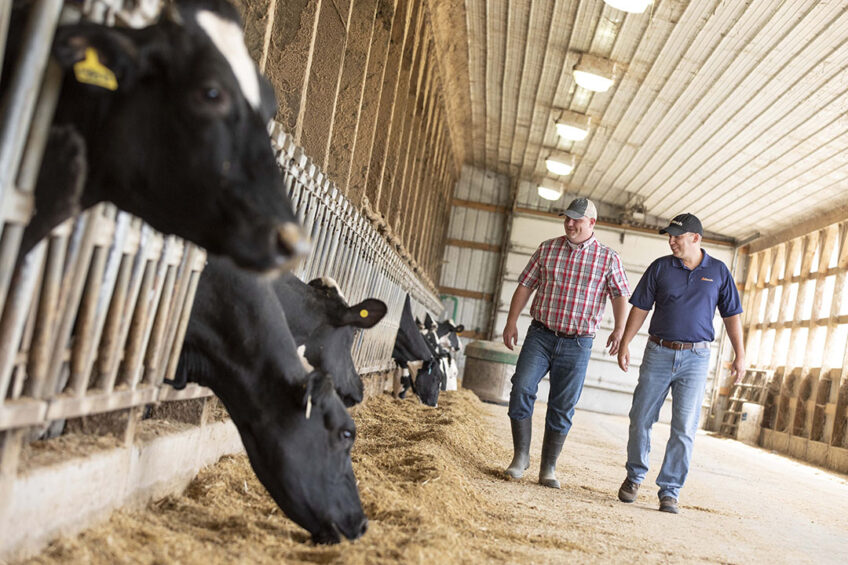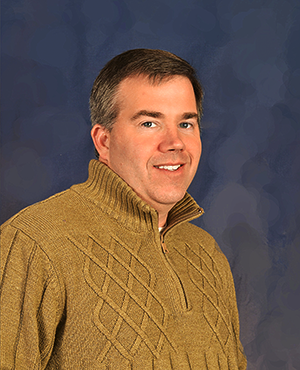Discover how low-protein diets with red clover silage, supplemented with starch or rumen-protected methionine, can optimize dairy cow performance and nitrogen efficiency.

In the complex realm of dairy farming, the delicate balance between optimizing cow performance and nitrogen efficiency is the key to economic viability and environmental sustainability. A practical strategy that emerges is the reduction of dietary crude protein (CP) while incorporating nutrient-rich feeds like red clover and grass silage. This approach can significantly enhance milk production and mitigate nitrogen excretion, a major contributor to environmental pollution. By delving into the interplay of dietary protein levels and supplements such as starch or rumen-protected methionine (RPMet), this article provides practical insights into how these feed adjustments can drive performance and nitrogen use efficiency (NUE) in dairy cows. We explore the benefits and practical implications of low-protein, red clover, and grass silage-based diets, from maintaining milk yields and quality to reducing urinary nitrogen waste and improving apparent NUE.
The Advantages of Lowering Protein Intake in Dairy Cow Diets
Implementing a low-protein diet for dairy cows is beneficial for nitrogen efficiency, environmental impact, and milk production.
- Improved Nitrogen Efficiency: Low-CP diets enhance nitrogen use efficiency (NUE). Maintaining metabolizable protein (MP) supply while reducing CP content results in higher NUE percentages, optimizing metabolic processes and reducing nitrogen wastage.
- Reduced Environmental Impact: Lower CP content decreases urinary nitrogen excretion, aiding in compliance with manure nitrogen regulations and reducing ammonia emissions, thus supporting sustainable agriculture.
- Enhanced Milk Production: Despite lower protein content, milk yield and quality (fat, protein, lactose) remain stable, allowing for cost savings without compromising production efficiency or quality.
The Role of Red Clover and Grass Silage
Red clover and grass silage are essential in sustainable dairy cow diets. Red clover, a legume, fixes nitrogen, enhancing soil health and reducing the need for fertilizers. It is highly palatable and digestible, improving dairy cow performance. Red clover is rich in protein and fiber and supports rumen function and milk production.
Grass silage complements red clover by providing a balanced forage that supports consistent intake and nutrient supply. Grass species like ryegrass have high sugar content, promoting better fermentation and increasing energy density. Red clover and grass silage together ensure a steady supply of energy and protein, which is not only essential for maximizing milk yield but also for maintaining cow health. This reassures us that these feed adjustments are not just about performance and efficiency, but also about the well-being of our cows.
Integrating these silages into a total mixed ratio (TMR) offers a balanced dietary approach, ensuring each bite is nutritionally complete. This reduces selective feeding and improves overall nutrient intake, which is crucial for stable milk production and optimal nitrogen use efficiency (NUE), especially when adjusting crude protein (CP) levels.
Our study refines dietary CP balance while maintaining metabolizable protein (MP) levels with supplements like starch or rumen-protected methionine (RPMet). This strategy aims to sustain and enhance performance metrics such as milk yield, composition, and NUE while reducing the environmental impact of dairy farming through lower nitrogen excretion.
Role of Red Clover in Dairy Cow Nutrition
Red clover plays a significant role in dairy cow nutrition, particularly enhancing nutrient digestibility. Research shows that its inclusion doesn’t significantly alter overall nutrient digestibility but helps maintain a balanced nutritional intake. This supports efficient digestion and metabolism in dairy cows.
Regarding milk quality, red clover silage offers notable benefits. While our study found that milk yield and significant components like fat and protein remain unaffected by dietary CP content, there were essential changes in milk and plasma urea concentrations and fatty acid profiles. These findings suggest that red clover silage positively influences milk’s nutrient profile, benefiting both milk processors and consumers. This highlights the strategic value of incorporating red clover in dairy cow diets.
Advantages of Grass Silage in Dairy Cow Rations
Incorporating grass silage into dairy cow rations provides several key advantages. Its high fiber content promotes proper rumen function and efficient digestion, improving nutrient extraction—the fiber aids in producing volatile fatty acids, essential for the cow’s energy supply.
Grass silage also supports rumen health. The fibrous structure fosters healthy microbial populations in the rumen, which is crucial for breaking down feed and absorbing nutrients. This can mitigate risks of metabolic disorders like acidosis, which are familiar with low-fiber diets.
Economically, grass silage is a cost-effective forage. It often requires fewer inputs than other forage crops, making it affordable for many dairy farmers. It can be grown in various soil types and climates, usually needing less fertilizer and pesticides while still providing adequate energy and protein for milk production.
Understanding Crude Protein: Why Less is More
Reducing dietary crude protein (CP) can cut costs and lessen milk production’s environmental impact. As high-protein diets become more costly and regulations on nitrogen emissions tighten, this is more relevant than ever. This study examines the benefits of lowering CP levels in red clover silage—a valuable but underutilized resource.
Reducing CP goes beyond cost savings. Environmentally, it lowers ammonia emissions and urinary nitrogen excretion. Our study found that cutting CP from 175 g/kg DM to 150 g/kg DM improved nitrogen use efficiency (NUE) without compromising dairy performance, meeting global sustainability goals.
Cows on low-protein (LP) diets with additional starch (LPSt) or rumen-protected methionine (LPM) maintained consistent milk yields and nutrient digestibility. This dispels myths about performance declines with lower protein intake. By ensuring adequate metabolizable protein (MP), producers can sustain optimal performance and reduce environmental harm.
Milk fat, protein, and lactose levels were stable across diets, suggesting no compromise in milk quality. Plasma urea and β-hydroxybutyrate concentrations also showed the body’s adaptive responses to reduced protein intake.
These results suggest a shift in dairy nutrition toward economic efficiency, environmental responsibility, and maintenance performance. Dairy producers can better meet modern farming challenges by using red clover silage with strategic protein reduction and supplementation.
Starch and Rumen-Protected Methionine: Key Supplements Explained
Starch and rumen-protected methionine (RPMet) enhance dairy cow diets’ nutritional profile and metabolic efficiency, especially legume silages like red clover. Starch from grains such as barley boosts energy, supporting microbial protein synthesis in the rumen, thus aiding milk production. It offers quick energy, which is crucial for peak lactation and high-energy demands.
Methionine is an essential amino acid critical for protein synthesis and metabolic functions. Rumen-protected methionine bypasses rumen degradation, reaching the small intestine intact for effective absorption and aiding milk protein synthesis and quality.
While supplementing low-protein diets with starch or RPMet theoretically offsets reduced crude protein levels, the study revealed no significant impact on overall milk yield or composition. However, RPMet supplementation altered metabolic parameters, increasing blood plasma β-hydroxybutyrate levels. Conversely, the LPSt diet reduced plasma urea concentrations, suggesting improved nitrogen utilization.
These findings highlight that starch and RPMet fine-tune dietary balance, but their broader metabolic effects are crucial. Increased nitrogen use efficiency (NUE) across all low-CP diets indicates a sustainable approach to dairy nutrition, reducing nitrogen excretion and environmental impact without compromising performance.
Comparing Dietary Treatments: Control vs. Low-Protein Diets
| Parameter | Control (CON) | Low-Protein (LP) | LP + Starch (LPSt) | LP + Rumen-Protected Methionine (LPM) |
|---|---|---|---|---|
| Dry Matter Intake (DMI) kg/d | 21.5 | 21.5 | 21.5 | 21.5 |
| Milk Yield (kg/d) | Unaltered | Unaltered | Unaltered | Unaltered |
| Milk Urea Concentration | Highest | Lower | Lower | Lower |
| Plasma β-Hydroxybutyrate Levels | – | – | Lowest | Highest |
| Apparent Nitrogen Use Efficiency (NUE) | 28.6% | 34.2% | 34.2% | 34.2% |
| Urinary Nitrogen Excretion (g/d) | Higher | ~60 g/d Lower | ~60 g/d Lower | ~60 g/d Lower |
In comparing the control diet (CON) with 175 g/kg DM of crude protein against the low-protein diets (LP, LPSt, and LPM) at 150 g/kg DM, we found no notable difference in dry matter intake (DMI), which averaged 21.5 kg/day across all diets. DMI did vary by week and diet, peaking in the LPSt diet during week four and in the CON diet during weeks 9 and 14.
Milk yield, energy-corrected milk (ECM), and 4% fat-corrected milk (FCM) were consistent across all treatments, suggesting a lower CP content did not affect overall milk production. Milk composition, including fat, protein, and lactose, remained stable. However, cows on the CON diet had higher milk and plasma urea levels, indicating excess nitrogen intake.
The blood plasma β-hydroxybutyrate levels varied, highest in the LPM diet and lowest in the LPSt diet. Improved nitrogen use efficiency (NUE) was observed in cows on low-protein diets, with an NUE of 34.2% compared to 28.6% in the control group. This shows the efficiency and environmental benefits of low-protein diets.
Nutrient digestibility, measured as the digestibility of organic matter, nitrogen, neutral detergent fiber (NDF), and acid detergent fiber (ADF), showed no significant differences across treatments. Yet, urinary nitrogen excretion was reduced by about 60 g/day in cows on low-CP diets, highlighting the environmental and economic advantages of lowering dietary CP without compromising animal performance.
The Bottom Line
Optimizing dairy cow performance while enhancing nitrogen use efficiency offers a dual benefit: sustainable milk production and reduced environmental impact. Dairy farmers can maintain milk yield and quality by adjusting crude protein levels with red clover and grass silage without compromising herd well-being.
Our analysis highlights the benefits of grass silage, the importance of maintaining adequate metabolizable protein (MP), and the roles of supplements like starch and rumen-protected methionine (RPMet). Reducing CP content from 175 to 150 g/kg DM leads to higher nitrogen efficiency (NUE) and lower urinary nitrogen excretion.
Adopting low-protein diets with red clover and grass silage is a promising strategy for dairy farmers focused on productivity and environmental regulations. Our findings show that these dietary adjustments do not hinder performance but promote sustainability. Consider integrating low-protein, red clover, and grass silage into your dairy cows’ diet to enhance nitrogen efficiency and overall herd performance.
Key Takeaways:
- Reducing dietary crude protein (CP) from 175 g/kg DM to 150 g/kg DM in red clover and grass silage-based diets, while maintaining metabolizable protein (MP) supply, does not compromise dairy cow performance.
- Supplementation with dietary starch or rumen-protected methionine (RPMet) in low-CP diets had limited impact on overall milk yield and composition.
- Cows on low-CP diets exhibited improved nitrogen use efficiency (NUE), with higher mean NUE values compared to those on standard CP diets.
- Milk and plasma urea concentrations were significantly lower in cows fed low-CP diets, indicating better protein utilization and reduced nitrogen wastage.
- Lower CP diets resulted in reduced urinary nitrogen excretion by approximately 60 g/d, supporting environmental sustainability and compliance with manure nitrogen regulations.
- The overall apparent nutrient digestibility remained consistent across different dietary treatments, suggesting that performance metrics are maintained despite reduced CP levels.
- Economic viability of milk production may be enhanced by reducing protein intake without sacrificing production efficiency or milk quality.
















 An effective nutrition consultant will investigate and analyze all the issues impacting your cows and thus impacting your success. The Bullvine went to Dr. Scott Bascom to get some insight on the value of working with a nutrition consultant. Dr. Bascom is the Director of Technical Services at
An effective nutrition consultant will investigate and analyze all the issues impacting your cows and thus impacting your success. The Bullvine went to Dr. Scott Bascom to get some insight on the value of working with a nutrition consultant. Dr. Bascom is the Director of Technical Services at  From the Bunker to the Bank!
From the Bunker to the Bank! Beyond the Basics to Practical and Personal
Beyond the Basics to Practical and Personal



